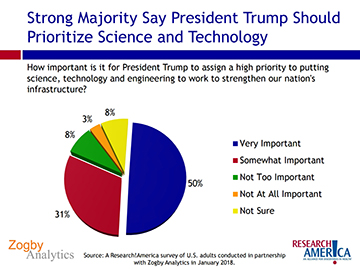A pie chart displaying the findings of one of the questions from the January 2018 Research!America survey. [Image: Research!America] [Enlarge image]
A recent public-opinion survey commissioned by Research!America has found that a significant majority of Americans think it’s important for President Trump and the current U.S. administration to prioritize science and technology, especially with respect to the country’s infrastructure. The nationwide survey focused on American attitudes on the intersection of science and politics and, more specifically, attitudes toward the current administration’s science and research priorities.
In response to the question, “How important is it for President Trump to assign a high priority to putting science, technology and engineering to work to strengthen our nation's infrastructure?” 81 percent of participants said either “very important” or “somewhat important.” A strong majority of those surveyed, from both major political parties, also agreed that Trump should assign high priority to research and innovation. Fifty-four percent answered “very important” to that question, a 12 percent increase from a similar question posed in 2017.
Basing public policies on science
According to the survey, 79 percent of people agreed that it was either somewhat or very important for the government to support incentives for private-sector research. Also, a clear majority of those surveyed agreed that scientists should play a major role in shaping public policy regarding research in medicine and health (82 percent), air and water quality (82 percent) and the environment (77 percent), among other subjects.
Large majorities of those surveyed said that candidates for the U.S. Congress should understand scientific issues (77 percent) and should assign high priority to research funding (80 percent). Most people also said that candidates should have science advisors. Notably, these findings held true across party lines for the majority of self-identifying Republicans and Democrats surveyed.
Other public-attitude trends uncovered by the survey include an opinion among most Americans that public policies should be based on the best available science and that the government should increase funding for rural health research.
Split views on America’s future
However, not all of the survey findings were clear majorities or minorities. Americans were more divided in their opinions on whether U.S. science innovation will strengthen in 2018. Thirty percent of those surveyed believe that America’s global stature in science innovation will strengthen this year, while 31 percent believe that it will weaken.
In his January 2017 inaugural address, President Trump said that America was in a position to leverage science, technology and innovation to overcome the nation’s obstacles; however, in the recent State of the Union address one year later, those topics were not revisited. Trump called for a US$1.5 trillion infrastructure investment, but R&D was notably absent from the loosely outlined plan. In response, the American Association for the Advancement of Science (AAAS) urged Trump to “include the rebuilding of our nation’s scientific research infrastructure, including national labs and research facilities, into his administration’s plan.”
According to Mary Woolley, president and CEO of Research!America, “Accomplishing bold goals like those President Trump set last year requires giving science and innovation a very high priority in his Administration … R&D is the infrastructure underlying job-creating, life-saving innovation. Achieving success in this important initiative requires bolstering the budgets of federal science agencies, incentivizing public-private partnerships, and placing a greater emphasis on STEM education.”
The survey was conducted by Zogby Analytics for Research!America in January 2018, and included 1,013 respondents. The margin of error was +/- 3.1 percentage points. More of the results can be seen in a slide set on the Research!America website.

